 TRIZ
Textbooks: CID Course for Children, 2-1W5 TRIZ
Textbooks: CID Course for Children, 2-1W5 |
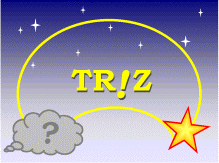  
|
| Topic 5.
Methods of Making Images
Lesson 1.
To Increase - To Shrink
Lesson
2. To Assemble -To Disassemble
Lesson
3. Upside Down
Lesson
4. To Speed Up - To Slow Down
Lesson
5. Transit in Time
Lesson
6. Binomial of Fantasy |
Fantasy
City:
Course of Creative Imagination
Development (CID), 2nd Grade, 1st Semester, Children Workbook |
Natalia
V. Rubina, 1998 [published
in Russian]
English
translation by Irina Dolina,
April 2, 2001
Technical
Editing by Toru Nakagawa, July
15, 2001 |
Published
in this "TRIZ Home Page in Japan" in English on Jul. 17, 2001 under the
permission of the Author.
(C) N.V.Rubina,
I. Dolina, T. Nakagawa, 2001 |
Guide-Book

Topic 5.
Methods of Making Images
Lesson 1.
To Increase - To Shrink
Emil has got for you a
new problem. Every day, coming home from work, a man doesn’t reach
his ninth floor but comes out at the sixth floor, and then he climbs the
stairs. Why?

The magician Deli-Davai
has a friend, a wizard Giant-Little One. Do you know why he has such
an unusual name? He can increase and shrink everything around.
Help the wizard to find out which is better to be big or small in order
to:
To enjoy a delicious cake
__________________
Not to be late for a train
__________________
To finish eating a nasty porridge
__________________
To reach the sky
__________________
To talk to the insects
__________________
The wizard Giant-Little
One can increase and shrink everything. But there is a certain condition:
he makes a small thing big and a big thing – small. Therefore, if you want
the wizard to increase anything, you need to prove that this object is
– small. And if you want to have it shrunk, prove that this object
is – big. So…
| I want to make it big: |
Prove that it is small: |
|
|
_______________________________
_______________________________ |
| I want to make it small: |
Prove that it is big: |
|
|
_______________________________
_______________________________ |
| I want to make it big: |
Prove that it is small: |
|
|
_______________________________
_______________________________ |
| I want to make it small: |
Prove that it is big: |
|
|
_______________________________
_______________________________ |
| I want to make it ______: |
Prove that it is ______: |
|
|
_______________________________
_______________________________ |
|
|
The wizard Giant- Little One prepared for
us an unusual assignment. How to draw a picture of the wizard Giant-
Little One that he should be big and small at the same time? |
| Activity.
While constructing a hospital in a small Finish town the architects have
come across a problem. All the buildings in the town are small, 2-3-stories.
The hospital according to the project has to contain many large premises
– the building must be big and high. How to combine such contradictory
demands? |
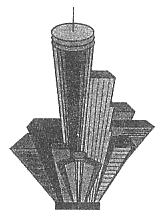 |
Guide-Book
Methods of
Making Images
Lesson
2. To Assemble -To Disassemble
Lev Nikolaevich Tolstoy
told his students the following parable:
A father had
three sons. They lived in peace and friendship, worked together in
a field, and helped each other in everything. Then their father grew
old and got sick. The sons began to look suspiciously at each other:
"Whom will our father leave his wealth…?"
The father found out
about it. He called his sons and said: ”I’ll give you an assignment”.
The one who carries it out, will be my heir. Here is a broom made
of willow twig – try to break it…” 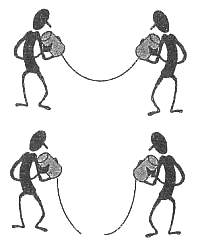
The brothers tried
to break the broom: turned it this way and that way but could do nothing.
They came to their old father: ”We can not carry out your assignment…”
“Well, well”, – said
the father, unwinding the string that kept the twigs together, – “every
separate twig can be easily broken, but if they are together, it is impossible
to break them. So in life: as long as you are together, you can not
be crushed, but if you are separated, it is easily done…”
The magician Deli-Davai
has taught us to assemble and disassemble things. We know that everything
in the world consists of parts and is a part of something even larger.
Today Deli-Davai will teach us to apply the method of assembling – disassembling
for solving creative problems and designing unusual toys. So…
Problem 1.
Once the telephone rang
in Emil’s house. His aunt asked him to bring her urgently the slim
long glass sticks, which she had left behind during her last visit.
Emil is always glad to help his favorite aunt, but there is a problem –
the sticks are long and slim: no matter where you put them they will get
broken. What to do?
Problem 2.
Once the troops of Alexander
the Great, King of Macedonia, came up to the river Sink. They stayed
along the river bank. On the other bank there were enemies.
The bonfires from their camp were seen. It was necessary to cross
the river and to take the enemies by surprise. There were three boats
near the shore. The great general started to think: if to put many
soldiers into each boat, it is dangerous , they may get drowned; if to
put less soldiers – there won’t be enough time before the morning.
What is to be done?
Problem 3. 
Once the scholars got
together to discuss how to fight the weevil. And it turned out that
they knew about this weevil very little. Nobody knew, for example,
what is the temperature of its body.
- Weevil is small, -
said one scholar, - a regular thermometer can not be used.
- We need to construct
a special device, - agreed another, - we’ll lose much time ...
And then the Inventor
appeared.
- We don’t need any new
devices, he said. Take an ordinary …
What did the inventor
proposed?
Let’s come back mentally
to the morphological chart. Designing a new toy, we also used the
method “assemble–disassemble”. In the next assignment it is necessary
to change simpler systems.
Draw any
system, consisting of triangles,
circles and squares. |
|
Guide-Book
Methods of
Making Images
Lesson
3. Upside Down
Never wash your hands
Ears, neck and face.
This is an unhealthy activity
That leads to nothing.
Your hands will get dirty again,
So your ears, neck and face. |
Why should you waste your strength,
Waste your time.
Having your hair cut is also useless,
Nobody needs it –
When you become old
Your head will get bold. |
|
G. Oster. |
| The Fairy
Inversion always act upside down, as Alice in the Wonder world.
Draw a picture of Fairy Inversion. |
|
There are words and even
whole expressions, which are read from the right to the left and from the
left to the right in the same way. They are called palindromes.
| [In Russian] |
[English translation] |
| Oh, I tiho! |
Oh, how quiet! |
| A rosa upala na lapu Asora. |
A rose has fallen on Azor’s paw. |
| Gorod ad, a dopog! |
|
Read upside down..
Do you know such words?
Find a character “upside
down”:
| Buratino |
– |
| Carlsson |
– |
| Winnie-the-Pooh |
– |
| Aibolit [Doctor
Powder and Pill] |
– |
| Chebyrashka [An unknown
animal] |
– |
| Neznaika [A
Know Nothing Boy] |
– |
| ? |
– |
Sometimes the rivers flow
in an opposite direction. It happens, for example, with Dnieper,
Ob, and other big rivers [in Russia].
During spring high flood the flows are free from ice quicker, and the water,
reaching the river-bed, come back..
How to make up a system “upside
down”?
| |
Your examples: |
| S => P => AP
=> AS |
|
| S => F => AF
=> AS |
|
Problem.
When the prosthetic appliance
is being made for the legs, it is very important that an artificial leg
was exactly like the real one. It seems not a difficult task – one
should make a mould from the real leg and make in it an artificial one.
But as a matter of fact, it doesn’t work because nobody needs the identical
legs. What should be done?
In Fantasy City there
is a street, where everything is upside down: a house – upside down, the
trees – upside down, the cars – upside down…
| Draw a picture of street
“upside down”. |
Guide-Book
Methods
of Making Images
Lesson
4. To Speed Up - To Slow Down
Two horsemen are contesting
which horse will come to the finish last. But nothing happens – they
both are standing still. They turned for an advice to a wise man.
The old man came up and whispered something to both of them. After
that they started to ride as fast as they could. What did the wise
man tell them?
How to find out who came
to the finish first?
Finish the sentences:
| I would like __________________ |
so fast to ______________________ |
| I would like __________________ |
so slowly to ______________________ |
| I would like __________________ |
so fast to ______________________ |
| I would like __________________ |
so slowly to ______________________ |
| I would like __________________ |
so fast to ______________________ |
| I would like __________________ |
so slowly to ______________________ |
What can be
fast and slow at the same time?
| Winnie-the-Pooh
and Piglet decided to go on a visit. On their way they met the wizard
Zamri-Otomri (Stand Still – Relax). He can slow down or speed up
everything. The wizard touched Winnie-the-Pooh and the little bear
stood still. He touched Piglet – the little pig began to roll like
a top. How can they go on a visit together? |
|
Make a picture of Zamri-Otomri.
|
|
In Fantasy City there
is an unusual tram: it goes sometimes very fast (as a plane) and sometimes
very slow (as a turtle). Make a schedule of this tram in such a way
that the inhabitants of the city should be happy to have such a tram.
| How to change the street
where the tram goes through? |
Guide-Book
Methods of
Making Images
Lesson
5. Transit in Time
He walked but his shoes
didn’t wear out. I decided to help him, but I did even worse: now
he can not walk even with my help. What are we talking of?
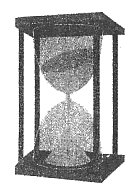
What is time? Even
the ancient philosophers were looking for an answer to this riddle.
Nothing seems so common as time! It exists everywhere – any event
is happening in time, and our life as well. But if one thinks deeper,
we all will face the Great Mystery of Time. So then not one, but
a whole ocean of questions will arise. Why time is universal?
Why does it flow everywhere.
Ancient philosophers used
to say: “One can not enter the same river twice”. Because between
the first and second entering time will pass and the water which you have
stepped in, will just flow away. There will be new water in the river
and it means that the river itself will be different.
But when you step into
the river for the first time, is the water still? Of course, not.
It flows all the time without a stop. Entering the water, you will
find out that the river changes continuously. So the ancient paradox
is justified. “One can not enter the same river twice".
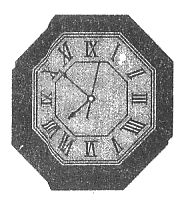
The similar thing happens
to the time. It flows everywhere and permanently. So, one can
not enter the river of Time twice. So to say, nothing can be done
in the same way. The most looking alike events will be different
after all, because they are separated in time. And what if they are
happening at he same time? It doesn’t make any difference, – one
can not enter the same river of Time twice. Therefore not a single
second resembles another one. Besides, this “the only one” second
will never repeat itself! One can find oneself in “the same place”
lots of times, but to be there “at the very same time" is impossible.
And it is so because time flows only in one direction – from the past to
the future and never flows back. So, what is the future or the past?
What is the present? Actually, if one thinks thoroughly, it appears
that the present does not exist after all. The present is just a
“transient apparition”, nearly an instant between the past and the future.
Some day the Great Mystery
of Time will be solved. But at present nobody knows for sure what
time is. Only one thing is obvious for everybody – one shouldn’t
waste time on trifles – it will never come back.
Guide-Book
Methods of
Making Images
Lesson
6. Binomial of Fantasy
“Doctor Poliphemo,
on coming home, looks for his jacket in his wardrobe and sees a dog inside.
The dog is of uncertain breed. Maybe he is trained for mushroom hunting,
or cyclomen [a flower] hunting, or rododendron
[a
flower] hunting. He is friendly, wags his tail, gives politely
his paw, but he wouldn’t get out of the wardrobe. No matter how much
time Doctor Poliphemo asked him to leave, the dog was implacable.
Poliphemo went to his bath room to take a shower and there, in the cabinet,
he discovered another dog. The third one is in the kitchen cabinet
surrounded by the saucepans, the fourth one – in a washing basin, one more
– in a half frozen state – a refrigerator. A pretty puppy is hiding
in a corner for the mops, and a small Bologneese is in a drawer of his
desk. 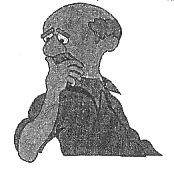
Doctor Poliphemo could
have called an operator and ask him to throw the uninvited guests out of
the apartment, but Doctor Poliphemo is a dog-lover and his heart prompts
him otherwise. He ran out to the butcher’s store and bought ten kilograms
of fillet to feed his guests. From now on every day he buys ten kilograms
of meet.
It can not passed
unnoticed. The butcher felt that something was wrong. Talks,
rumor and aspersion started. What if Dr. Poliphemo is hiding in his
apartment the spies, who are after the nuclear secrets? What if he
performs some devil experiments in his apartment? Why does he need
so much meet ? The poor doctor began to lose his clients. The
police got some information against Poliphemo. The head of the Police
ordered to search the doctor’s apartment. Only then it became clear
that Dr. Poliphemo suffered because he was a dog lover."
(G. Rodari: "Grammar of Fantasy", Moscow, “Progress”, 1990, pp. 28.)
What does the word “binomial”
mean?
So, choose two words:


Unite them, using different
prepositions (in, on, near, under, over and others):
–
–
–
–
–
–
–
Supplement the ideas you
got:
| Maybe you need a drawing
for the illustration. |
|
____________________________________
____________________________________
____________________________________
____________________________________
____________________________________
____________________________________
____________________________________
____________________________________
____________________________________
____________________________________
____________________________________
____________________________________
____________________________________
____________________________________
____________________________________
____________________________________ |
Last updated
on Jul. 17, 2001. Access point: Editor: nakagawa@utc.osaka-gu.ac.jp







